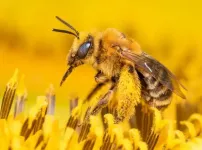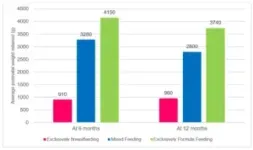(Press-News.org) A team of researchers led by Rutgers University-New Brunswick scientists has analyzed crop yields of more than 1,500 fields on six continents, and found that production worldwide of important, nutritionally dense foods such as fruits, vegetables, nuts and legumes is being limited by a lack of pollinators.
The results, detailed in Nature Ecology & Evolution, showed that across diverse crops and locations, one-third to two-thirds of farms contain fields that aren’t producing at the levels they should be due to a lack of pollinators. The phenomenon of a low crop yield because of insufficient visits by insects is known as pollinator limitation.
The study is especially timely given recent concern about global declines in insect abundance.
“Our findings are a cause for concern and optimism,” said Katie Turo, an author of the study and a postdoctoral fellow in the Department of Ecology, Evolution and Natural Resources in the Rutgers School of Environmental and Biological Sciences. “We did detect widespread yield deficits. However, we also estimate that, through continued investment in pollinator management and research, it is likely that we can improve the efficiency of our existing crop fields to meet the nutritional needs of our global population.”
The scientists reached their conclusions by conducting a statistical analysis of more than 200,000 “bee visitations” to crop flowers, contained within one of the most comprehensive databases on crop pollination in the world. Rachael Winfree, the senior author on the study and a professor in the Department of Ecology, Evolution and Natural Resources, collaborated with several colleagues from Europe and South America to compile the most comprehensive database of crop pollination studies in the world. The open-source database incorporates three decades of field observations of bees and other pollinators visiting plants.
The recent Rutgers study doesn’t apply to major food crops, such as rice and wheat, which don’t require pollinators to reproduce. But pollination by bees and other animals is critical to the proliferation of what Turo describes as “nutrient-dense and interesting foods that we like and are culturally relevant,” such as fruits, vegetables, nuts, and legumes.
“If you look through a list of crops and think about which fruits and vegetables you’re most excited to eat— like summer berries or apples and pumpkins in the fall—those are the crops that typically need to be pollinated by insects,” Turo said.
Pollination is the process of transferring pollen from the male part of a flower to the female part, which allows a plant to become fertilized and produce seeds, fruits and young plants. Pollen can be moved by wind, water or pollinators such as honeybees and wild bees and other insects and other animals, such as bats.
Pollinators support the reproduction of about 88 percent of the world's flowering plants and 76 percent of the leading global food crops, according to previous research by Rutgers professor Rachael Winfree and other scientists. Bees are generally considered the most effective pollinators because Rutgers scientists identified that blueberry, coffee and apple crops were most frequently affected by pollinator limitation. they visit more flowers and carry more pollen than other insects.
Researchers found yield deficits for 25 unique crops and in 85 percent of the countries evaluated.
On the bright side, Turo said that scientists believe current yield deficits could be remediated with realistic increases in pollinator visitation across individual crop fields. The study revealed in some cases an adequate number of bees were already visiting some fields.
If field managers could improve consistency across high- and low-yield fields, much of the observed yield problems could be addressed, she said.
“The findings are significant because crop yields, which measure the amount of crops grown per unit area of land, are relevant to assessing the adequacy of the world’s food supply relative to its population,” Winfree said. “Our findings show that by paying more attention to pollinators, growers could make agricultural fields more productive.”
James Reilly, a data analyst in the Rutgers Department of Ecology, Evolution and Natural Resources, also was an author on the study. Other authors included Ainhoa Magrach of the Basque Centre for Climate Change in Leioa, Span, and Thijs P. M. Fijen of Wageningen University & Research in the Netherlands.
END
Are crops worldwide sufficiently pollinated?
A Rutgers-led study shows diminished crop yield is globally common but low yields could be addressed by increasing the number of pollinators
2024-08-27
ELSE PRESS RELEASES FROM THIS DATE:
American Meteorological Society announces 2025 weather, water, and climate honorees
2024-08-27
The American Meteorological Society is proud to announce its 2025 Awards and Honors, recognizing outstanding contributions to the weather, water, and climate community. 2025 recipients will be honored at the 105th AMS Annual Meeting in New Orleans, 12–16 January, 2025.
“One of our key priorities at AMS is to recognize the work of our global weather, water, and climate enterprise for the impact they have on scientific advancement and public safety, as well as on economic growth for all communities,” says Awards Oversight Committee Chair ...
Montana State scientists publish bacterial immune research in Nature
2024-08-27
BOZEMAN – Scientists at Montana State University have been studying unique immune systems for decades, and a research team in the Department of Microbiology and Cell Biology took another step forward with work described in a paper published in the highly regarded journal Nature.
The Aug. 7 paper, titled “A virally-encoded tRNA neutralizes the PARIS antiviral defense system,” was fast-tracked for publication by the journal due to the importance of the findings. MSU doctoral student ...
NIH prize challenge recognizes undergraduate biomedical engineers for innovative medical device designs
2024-08-26
The National Institutes of Health (NIH) and the higher education non-profit VentureWell have selected 11 winners and five honorable mentions in the Design by Biomedical Undergraduate Teams (DEBUT) Challenge, who are set to receive prizes totaling $160,000. The awards will be presented to the winning teams on Oct. 25, 2024, during the annual Biomedical Engineering Society conference in Baltimore.
Now in its 13th year, the annual DEBUT Challenge calls on teams of undergraduate students to identify ...
NJIT and Illinois research on data analytics will measure impact of scientific literature
2024-08-26
Three distinct problems in data science — trend identification in graphs, the quantitative study of scientific literature and evaluation of single-cell genomics — will all be addressed by new research in large-scale network analytics, jointly led by Distinguished Professor David Bader at New Jersey Institute of Technology.
The problems have a common challenge of finding patterns, known as community detection, from inside incredibly large datasets. Work is funded by a $648,000 National Science Foundation grant, Cyber-Infrastructure ...
UCLA receives $1 million NSF grant to accelerate commercialization of quantum technologies
2024-08-26
Researchers from the California NanoSystems Institute at UCLA and their colleagues have received a one-year, $1 million grant as part of a new National Science Foundation program aimed at accelerating the development and commercialization of quantum technologies for the benefit of society.
The Quantum Sensing and Imaging Lab, or Q-SAIL, which will be led by UCLA quantum physicist David Leibrandt, is one of five pilot projects across the country selected by the NSF to participate in the agency’s new National Quantum Virtual Laboratory, a first-of-its-kind national resource to enable the faster ...
3D shapes of viral proteins point to previously unknown roles
2024-08-26
SAN FRANCISCO—Viruses are tricky to keep up with. They evolve quickly and regularly develop new proteins that help them infect their hosts.
These rapid shifts mean that researchers are still trying to understand a multitude of viral proteins and precisely how they increase viruses’ infecting abilities—knowledge that could be crucial for developing new or better virus-fighting treatments.
Now, a team of scientists at Gladstone Institutes and the Innovative Genomics Institute led by Jennifer Doudna, PhD, have harnessed computational tools to predict the three-dimensional shapes of nearly 70,000 viral ...
UVA's first-ever data science majors begin their journey
2024-08-26
A new era at the University of Virginia’s School of Data Science officially kicked off, as the inaugural class of data science undergraduate majors arrived for orientation on the eve of UVA’s first day of classes.
Throughout the day at the new School of Data Science building, students heard from faculty and staff, learned more about their curriculum, took headshots and a group photograph, and began to familiarize themselves with classrooms and other features of the facility that would be their academic home.
The day also served as a call to action, as students learned not only what requirements would be needed to complete their degree but what a data ...
High BMI eligibility for semaglutide could cost Medicare an additional $145 billion annually
2024-08-26
Embargoed for release until 5:00 p.m. ET on 26 August 2024
Annals of Internal Medicine Tip Sheet
@Annalsofim
Below please find summaries of new articles that will be published in the next issue of Annals of Internal Medicine. The summaries are not intended to substitute for the full articles as a source of information. This information is under strict embargo and by taking it into possession, media representatives are committing to the terms of the embargo not only on their own behalf, but also on behalf of the organization they represent.
----------------------------
1. High ...
Brigham-led study estimates 1 in 7 Medicare beneficiaries with high body mass index may qualify for anti-obesity drug
2024-08-26
If Medicare Part D narrowly defines cardiovascular disease, majority of patients would remain ineligible while new federal spending could still exceed $10 billion
Current federal regulation restricts Medicare from covering drugs prescribed solely for weight loss. However, in March 2024, Medicare announced it would extend coverage to semaglutide (Wegovy), a popular glucagon-like peptide-1 receptor agonist (GLP-1RA), for patients with elevated body mass index (BMI) who also had established cardiovascular disease (CVD). This means that the definition of “established CVD,” which has not been ...
$66 million in 10 years: Groundbreaking strategic investment fund to drive biomedical innovation in Australia
2024-08-26
With a grand vision of investing $66 million over 10 years in groundbreaking medical innovations, WEHI’s first strategic investment fund, 66ten, is the largest internal pre-seed and seed fund created by an Australian medical research institute.
Managed by WEHI Ventures, 66ten serves the sole purpose of bridging the gap between scientific discoveries and commercial viability, ultimately creating both positive outcomes for patients and healthcare systems globally as well as financial returns to investors.
Since its foundation a year ago, 66ten has ...
LAST 30 PRESS RELEASES:
Sleeping in on weekends may help boost teens’ mental health
Study: Teens use cellphones for an hour a day at school
After more than two years of war, Palestinian children are hungry, denied education and “like the living dead”
The untold story of life with Prader-Willi syndrome - according to the siblings who live it
How the parasite that ‘gave up sex’ found more hosts – and why its victory won’t last
When is it time to jump? The boiling frog problem of AI use in physics education
Twitter data reveals partisan divide in understanding why pollen season's getting worse
AI is quick but risky for updating old software
Revolutionizing biosecurity: new multi-omics framework to transform invasive species management
From ancient herb to modern medicine: new review unveils the multi-targeted healing potential of Borago officinalis
Building a global scientific community: Biological Diversity Journal announces dual recruitment of Editorial Board and Youth Editorial Board members
Microbes that break down antibiotics help protect ecosystems under drug pollution
Smart biochar that remembers pollutants offers a new way to clean water and recycle biomass
Rice genes matter more than domestication in shaping plant microbiomes
Ticking time bomb: Some farmers report as many as 70 tick encounters over a 6-month period
Turning garden and crop waste into plastics
Scientists discover ‘platypus galaxies’ in the early universe
Seeing thyroid cancer in a new light: when AI meets label-free imaging in the operating room
Neutrophil-to-lymphocyte ratio may aid risk stratification in depressive disorder
2026 Seismological Society of America Annual Meeting
AI-powered ECG analysis offers promising path for early detection of chronic obstructive pulmonary disease, says Mount Sinai researchers
GIMM uncovers flaws in lab-grown heart cells and paves the way for improved treatments
Cracking the evolutionary code of sleep
Medications could help the aging brain cope with surgery, memory impairment
Back pain linked to worse sleep years later in men over 65, according to study
CDC urges ‘shared decision-making’ on some childhood vaccines; many unclear about what that means
New research finds that an ‘equal treatment’ approach to economic opportunity advertising can backfire
Researchers create shape-shifting, self-navigating microparticles
Science army mobilizes to map US soil microbiome
Researchers develop new tools to turn grain crops into biosensors
[Press-News.org] Are crops worldwide sufficiently pollinated?A Rutgers-led study shows diminished crop yield is globally common but low yields could be addressed by increasing the number of pollinators





